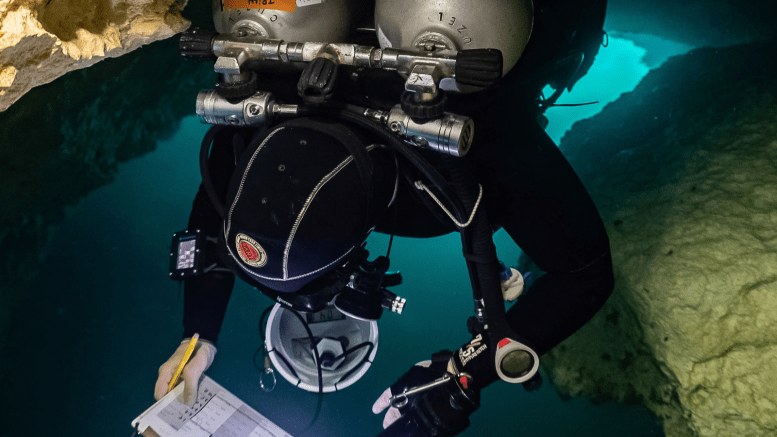Patricia Beddows speaks of scuba diving with an undeniable enthusiasm. She smiles when detailing the joys of being underwater. Her eyes gleam when she talks about democratizing underwater scientific research. Her energy rises when discussing the “complex and challenging” natural world.
One of the world’s foremost cave-diving scientists and co-founder of the groundbreaking Cave Pearl Project, Beddows has helped to redefine underwater scientific research and empowered citizen scientists to become active contributors.
“Water is vital to the planet’s livelihood and my hope is that the science I do contributes to healthier environments on the planet,” says Beddows, an associate professor of instruction in the Department of Earth and Planetary Sciences at Northwestern University’s Weinberg College of Arts & Sciences.
The marvels of the underwater world
Diving would seem an unlikely pursuit for a woman born and raised in “middle of nowhere Canada,” but Beddows grew up on a lake devoting her summers to fishing, swimming, and catching frogs. Yet, despite those adolescent ties to the water, Beddows could only dream of scuba diving.
As an undergraduate student at McMaster University in Ontario, Canada, however, Beddows participated in an open-water dive in the St. Lawrence River. Despite the cold water temperature, low visibility, high currents, and significant river traffic, Beddows loved the experience.
“It wasn’t a comfortable first experience, but I was hooked,” says Beddows, who soon began training as a master diver.
During those same undergraduate years, Beddows also developed a passion for Earth sciences. As part of a course on caves and karst, she visited Mammoth Cave in Kentucky and became further enchanted by the world’s natural splendor.
“That’s when I realized I didn’t have to choose,” Beddows says. “I could bring two passions – diving and Earth sciences – together.”
While pursuing a master’s degree in carbonate hydrogeochemistry at McMaster, Beddows initiated a research project in the Yucatan Peninsula. Unable to cave dive herself per her mentor’s orders, it was a painstakingly slow effort as Beddows relied on divers to bring her data. She often spent weeks getting answers to questions that would inform her next scientific steps.
“It was like doing science by remote control,” Beddows laments.
But soon after starting her PhD studies at the University of Bristol in 1999, Beddows began training as a cave diver to energize her research.
Going underwater herself with a defined set of scientific tasks, Beddows’ research accelerated. Her work in the Yucatan Peninsula generated dozens of published papers on topics such as groundwater, climate change, and contaminant transfer. It also motivated Beddows to investigate more efficient and cost-effective underwater monitoring.
“The traditional methods simply fell short,” she says.
Advancing science and access
In 2014, six years after joining the Weinberg College faculty, Beddows teamed with cave diver Edward Mallon to launch the Cave Pearl Project, a novel effort to remove the financial barriers of underwater science and fuel deeper understanding.
Previous to the Cave Pearl Project, monitoring water in caves demanded a sizable investment in technical equipment, a reality severely hampering research efforts. Beddows and Mallon changed that by developing an open source, data-logging platform using inexpensive components.
Today, Beddows maintains a network of more than 100 loggers around the globe – in caves, at coastal outflows, and at locations around reefs. The still-growing monitoring network includes everything from surface weather stations, underground drip monitors, and micro-climate recorders to novel pendulum flow meters providing rare data on the cave rivers coursing hidden beneath the surface. Those, however, are just the ones operated by Beddows; she estimates hundreds of other units built using the open-source plans are serving science globally as well.
“Dr. Beddows has enabled citizen scientists around the world to take water monitoring into their own hands,” says Natalie Gibb, a cave explorer and frequent collaborator with Beddows.
For Beddows, the Cave Pearl Project accomplishes two important objectives: first, it brings a broader group of people into environmental science by reducing financial constraints; and second, it delivers substantiative, verifiable data about water environments around the world.
“The continued establishment and refinement of this monitoring network is a valuable resource to advancing science,” Beddows says.
Committed to the future
For her sustained and valuable contributions to underwater science, Beddows was inducted into the Women Divers Hall of Fame (WDHOF) Class of 2021. The WDHOF recognizes women divers who have made outstanding contributions to the exploration, understanding, safety, and enjoyment of the underwater world.
“Not only is Dr. Beddows an accomplished hydrogeologist and professor, but she is a skilled cave diver who uses those skills to further cutting-edge science and a willing mentor to the next generation of women scientists and divers,” says Gibb, who nominated Beddows for WDHOF enshrinement.
Lofty honors aside, Beddows has no plans to slow down.
She promises to continue overseeing the growth of the Cave Pearl Project and co-hosting an annual Science Week with Gibb for cave divers interested in citizen science.
And as director of Northwestern’s “vigorous and growing” Environmental Science Program, Beddows will continue encouraging students to pursue thoughtful solutions for the natural and human world, which includes teaching a course – Earth 360: Instrumentation and Field Methods – that tasks students to construct and code devices to answers the toughest scientific questions that interest them without substantial financial constraints.
“I want to keep pushing forward and see environmental and Earth sciences flourish at Northwestern and in this world,” she says.
Video Below: Patricia Beddows, associate professor of Earth and Planetary Sciences, leads an annual spring break trip to Mexico, because one of the best tools to understanding our world is experiencing it firsthand. From the lagoon to the beach and beyond, Beddows uses the trip to educate her students on accessible basics of carbonate systems, sedimentology and coastal processes. Weinberg college undergraduates, PhD students and faculty make up a group that transcends all levels of learning.
Learn more about the Cave Pearl Project, featured Science Week’s video here

